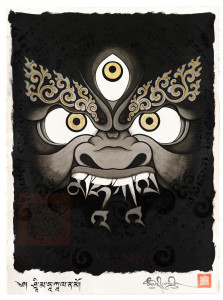My friend Robert sent me a message this morning, offering me a vision of Mahakala for my family. This moved me to tears.

Though I am not attaching Robert’s words here, I did want to take a moment and preserve his message here in another way.
I found this great summary:
This chant was written by the Vidyadhara in 1975 at the Boston Dharmadhatu.
mahakala (San; “great black one”): A dharmapala predicted by the Buddha, Four-Armed Mahakala is a particular protector of the madhyamaka teachings and of the Chakrasamvara tantra. He was also a special protector of Surmang. His symbolism is based on vajra anger and compassion. As described in The Myth of Freedom, his four arms represent the four karmas:
One left arm holds a skull cup of amrita, the intoxicating nectar of the gods, which is a means of pacifying.
One right arm holds a hooked knife, a symbol of enriching.
The second right arm holds a sword, which is a way of magnetizing or gathering together energies. The sword need not strike; just by its being waved, the energies are rallied.
The remaining left arm holds the trident which destroys or subdues. Its three prongs cut through the root kleshas of passion, aggression, and ignorance with one thrust.
Mount Malaya: This may refer to a mountain on the island of Sri Lanka, said to be the dwelling place of Vajrapani, the Lord of Secret.
blood lake Koka: At the foot of Mount Malaya lies a lake which includes an island by this name.
charnel ground: The charnel ground, an open field filled with corpses and beasts of prey, is a potent symbol in vajrayana. It represents the ground from which all phenomena are born and die, the basis of both samsara and nirvana.
Rudra or Matram Rudra (San.): Originally a Hindu deity, an emanation of Shiva. In the vajrayana, Rudra is the personification of ultimate ego, the opposite of buddhahood. Rudra’s corpse (confused ego) is scattered on the charnel ground, from which mahakala (enlightened energy) arises.
samaya (San.): A vajrayana vow of commitment, binding the student’s total experience, to the path of meditation. Samaya is the bond that links together the student, the teacher, and the teachings.
SAMAYA JAH: A mantra that invokes the presence of the deity; it is also a confirmation of the deity’s presence.
vajra (Tib. dorje): Adamantine, indestructible. In general, the “vajra” indicates what is beyond arising and ceasing, hence indestructible. Here, it indicates the uncompromising quality of the Four-Armed Mahakala.
sword: A sword generally represents the sharp double edge of prajna or intellect, which cuts through the concepts of self and phenomena in one stroke. The sword does not need to strike; energies are gathered just by its being waved.
khatvanga (San.): A staff, usually surmounted by a vajra or a trident and ornamented with three heads.
Raven-Headed One (San. Kaka-mukha, “Raven Faced”): An action protector, a servant of Four- Armed Mahakala, whose nature is the masculine aspect of destruction. Like a raven, he preys upon and consumes whatever endangers the teachings. He holds a hooked knife and a skull cup.
Künga Namgyal: The fourth Trungpa Tulku, who spent six years in retreat at Dorje Khyung Dzong. He bound Four-Armed Mahakala as a protector of Surmang monastery.
Dorje Khyung Dzong (Tib. “Vajra Garuda Fortress”): A cave and retreat center near the Surmang monastery of Dütsi-tel, used for meditation retreat.
four karmas: Four enlightened styles of activity for working with situations; four stages or levels of taming ego completely. These are pacifying, enriching, magnetizing, and destroying:
pacifying: The activity of feeling the ground very softly and cooling it out; subduing psycho-logical imbalance or physical sickness.
enriching: The activity of feeling further the texture of the situation and bringing it to full expression; extending your influence over others; generously spreading your rich and dignified quality all over.
magnetizing: The activity of bringing the elements of a situation together, provoking it into ferment; also, attracting power and relationships which give control of situations.
destroying: The activity of penetrating confusion and annihilating obstacles. When there is a strong self-justifying pseudo-logic, compassion may demand razing a situation in order to clear the ground.
Practice Lineage: This is an epithet applied to the Kagyü lineage, which emphasizes a strong allegiance to meditation practice. It can also be applied to the Nyingma lineage.
OM MAHAKALAYA DEVA-RAKSHA SAMAYA HO BALIM TE KHAHI: This can be translated as “OM (homage to) Mahakala, O protector of devas, (keep) the samaya. Eat this food offering.”
Source: http://nalandatranslation.org/offerings/notes-on-the-daily-chants/commentaries/four-armed-mahakala/
Be First to Comment